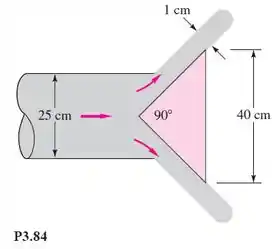Ar a 20°C e 1 atm escoa em um duto de 25 cm de diâmetro a 15 m/s, como na Figura P3.84. Na saída, o ar atinge um cone de 90°, como mostra a figura. Calcule a força do escoamento de ar sobre o cone.

Passo 1
Bora lá pra mais uma!
Temos que saber a velocidade de saída né?! Então vamo lá! Temos pela equação da continuidade que
Daí,
Nossa vamos considerar como um anel de diâmetro de 40 cm e espessura de 1 cm, assim:
Passo 2
Vamos encontrar a massa específica do ar, assim:
Agora, vamos fazer a análise de momento usando o balanço de forças, assim:
Resposta
22,8 N